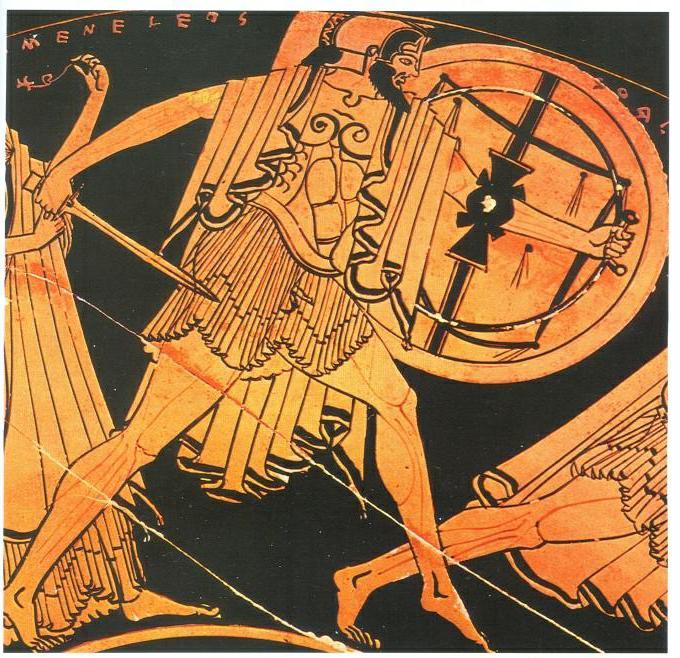A unique reenactment of a Greek hoplite (rather a general or commander) by the Spanish historical association and reenactment group Athena Promakhos (copyright: Athenea Promakhos /Denis F.). Kudos to them for their fine work on the topic of ancient Hellenic warfare.
Hoplite military equipment
31/03/2022
Uncategorized Ancient Greece, Ancient warfare, Greek warfare, helmet, Hoplite, hoplite phalanx, hoplite warfare, Military, Military history, Military technology, Sparta Leave a comment
Hoplite phalanx reenactment
15/02/2021
Uncategorized Ancient warfare, Greece, Greek warfare, Greeks, Hoplite, hoplite warfare, Shield 1 Comment
A fine reenactment of a hoplite phalanx by the Australian historical reenactment group Sidney Ancients. Kudos to them for their work.
Τα επιμέρους τμήματα μιας πλήρους οπλιτικής θωράκισης και ασπίδας
22/06/2020
Uncategorized Hoplite, hoplite formation, hoplite shield, hoplite warfare, ασπίδα, θωράκιση, οπλίτης, οπλιτικός Leave a comment
Στη σύζυγο μου Νέλλυ
Μια ενδιαφέρουσα εικόνα που παρουσιάζει τις ονομασίες των επιμέρους τμημάτων μιας πλήρους θωράκισης και της ασπίδας ενός οπλίτη. Πρόκειται για μετάφραση από την ίδια εικόνα που υπάρχει σε βιβλίο της Cassell publ.
THE HOPLITE SHIELDS
11/10/2017
Uncategorized Ancient warfare, Athenians, Athens, Boeotia, Greece, Greeks, Herodotus, Hoplite, hoplite phalanx, hoplite warfare, Military topics, Shield, Sparta, Spartans 7 Comments

A vase painting depicting a hoplite, 5th century BC. He is armed with a bronze cuirass, a hoplite sword and a hoplite shield of the Argive type. In the interior of the hoplite shield, you can see the “antilave” («αντιλαβή», handle/handgrip), the “porpax” («πόρπαξ», fastener for the elbow) and the “telamons” («τελαμώνες», shoulder belts)/ (Paris, Louvre Museum)
–
By Periklis Deligiannis
.
The Geometric Period (11th-8th centuries BC) preceded the invention of the hoplite warfare and the hoplite phalanx (about 700 BC). The shields of the Geometric period belonged to two main types: the “Dipylon” type shield and the “Herzsprung” type. The Dipylon shield is named after the Athenian Dipylon gate, where a number of pottery with depictions of that type of shield, was discovered. It was a large and long shield, covering the warrior from chin to knees. It was made of wicker and leather, without excluding further strengthening of wooden parts. Despite its size, the Dipylon shield was light due to its materials. It had a curved form in order to embrace the warrior’s body. In the middle of its surface, the Dipylon shield had two semicircular notches for the easier handling of the offensive weapons (spear or sword). Notches also facilitated the hanging (suspension) of the Dipylon shield on the warrior’s back, in order not to restrict his elbows when he walked. The shield had at least one central handle for its holding by the warrior in battle, and one or more shoulder belts, in order to hang it on his back when not used. These belts were called “telamones” (τελαμώνες). The shape of the Dipylon shield denotes its origins from the famous Minoan and Mycenaean eight-shaped shield. During the Greek Archaic Era (7th cent – 479 BC), the Dipylon shield was made mostly of bronze and had a smaller size: that is the “Boeotian” type of shield, named after Boeotia, where it was popular.
LEONIDAS’ LUCKLESS BROTHER: DORIEUS THE SPARTAN
15/01/2016
Uncategorized Ancient warfare, Cleomenes, Cyrenaean, Cyrene, Greece, Greek, Hoplite, hoplite formation, hoplite phalanx, Leonidas, Libya, Military topics, Sparta, Spartan Leave a comment
.
By the end of the sixth century BC, Anaxandridas of the Agiad royal family, one of the two Spartan kings (Sparta had two kings), had a difficulty in bearing children from his first wife. The Spartan ephors forced him to take a second wife – despite the southern Greek monogamy – in order to obtain a successor. Anaxandridas’ second wife gave birth to Cleomenes, who was destined to become one of the most skilful Spartan kings. However, shortly after the birth of Cleomenes, Anaxandridas’ first wife also gave birth to a son, named Dorieus. Although Dorieus came from the king’s first wife, Cleomenes succeeded Anaxandridas to the throne as firstborn. Dorieus became furious because of the takeover of royal power by Cleomenes. Thus he decided to organize a colonization campaign, in order to leave forever Sparta (515 BC). His first choice for the founding of his colony, was the site of the river Kinyps in Libya. The men who followed him out were referred by the sources as “Lacedaemonians” and it seems that they included a few real Spartans (Spartan citizens, called omoioi). The Spartan omoioi followers of Dorieus were mainly his personal friends and some members of his political faction. The majority were other Lacedaemonians, mainly hypomeiones (fallen citizens, ex-Spartans who were just beginning to become numerous), perioikoi (free Lakonian, Messenian and Pylian subjects of Sparta) and Peloponnesian allies.










